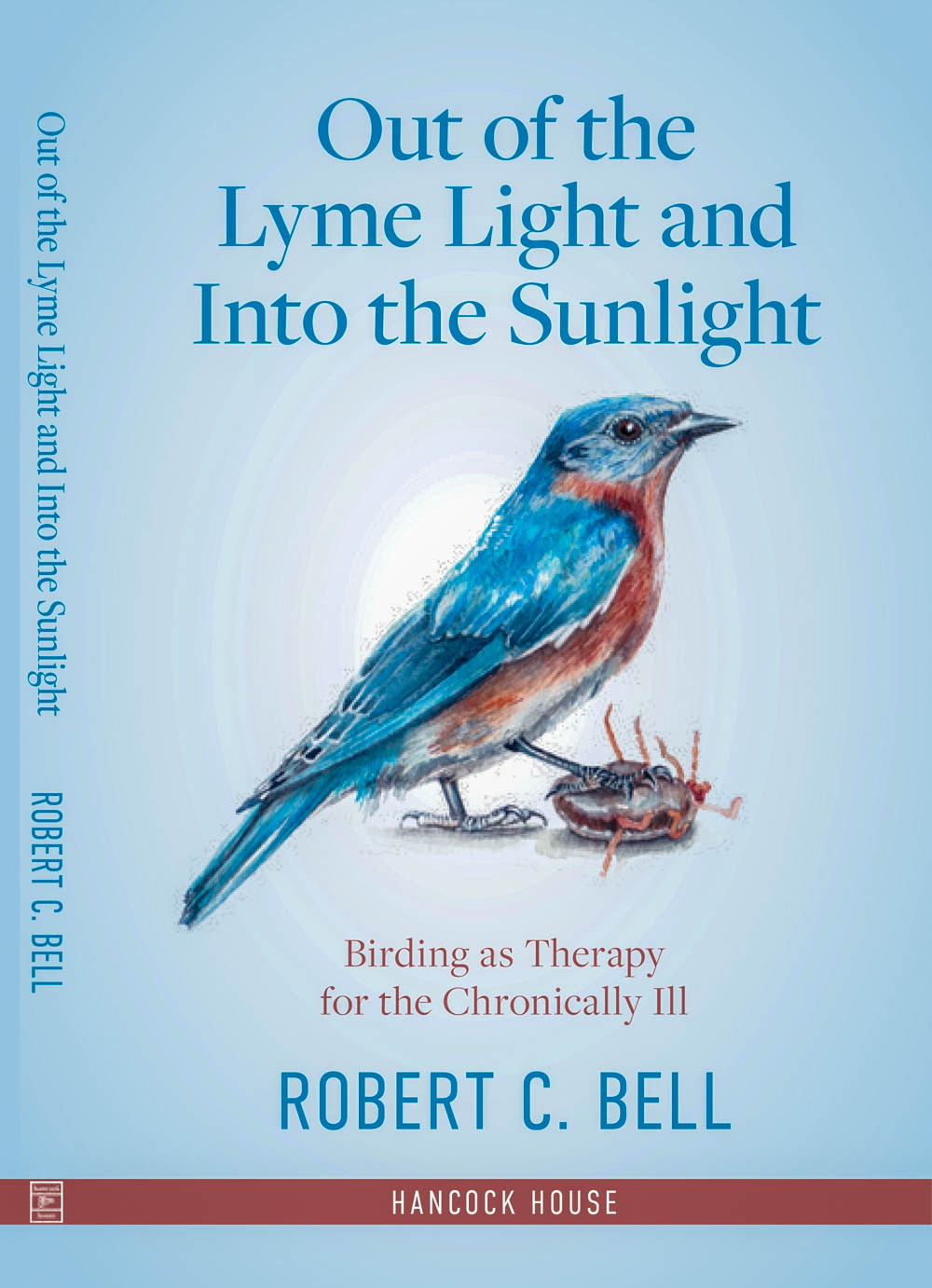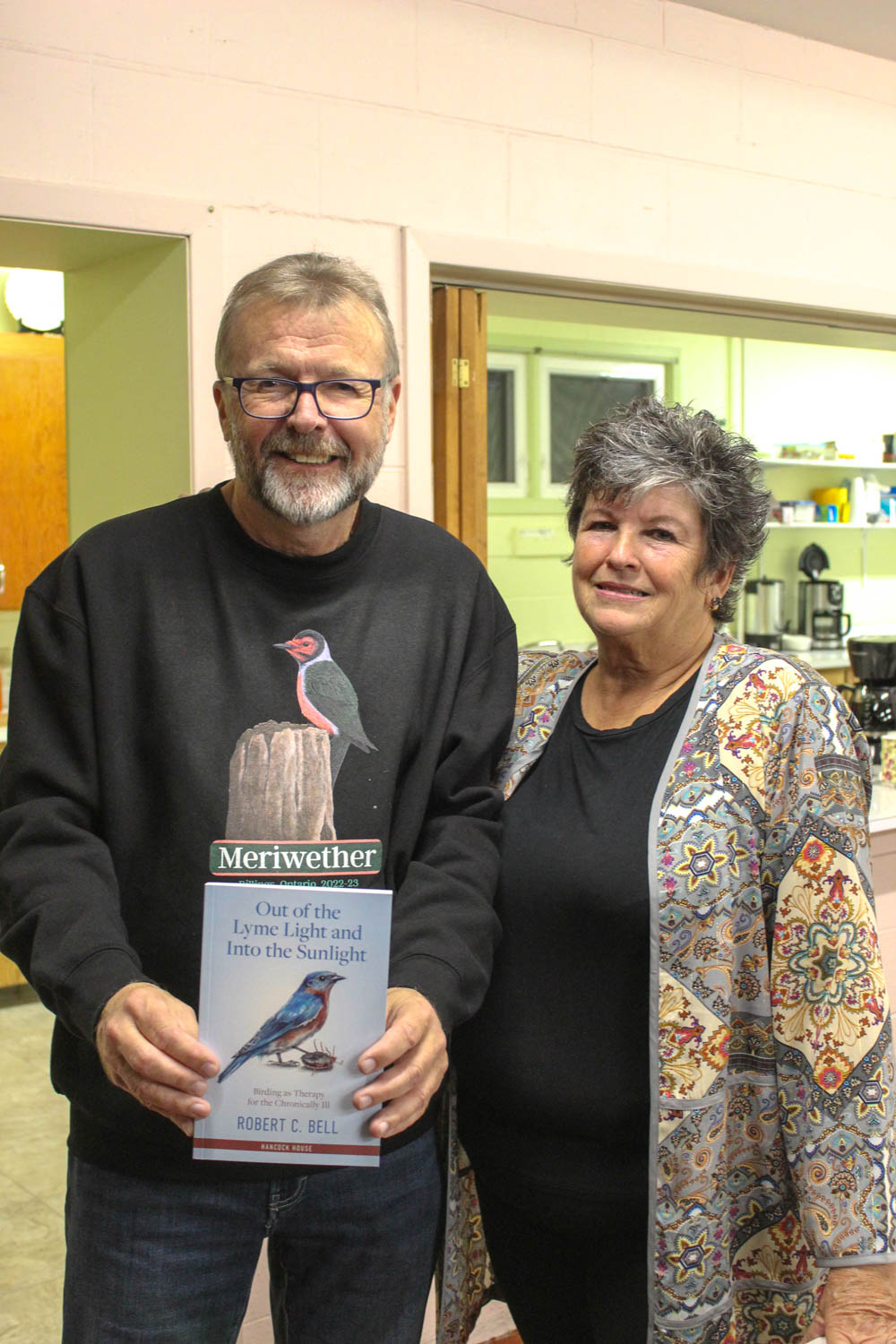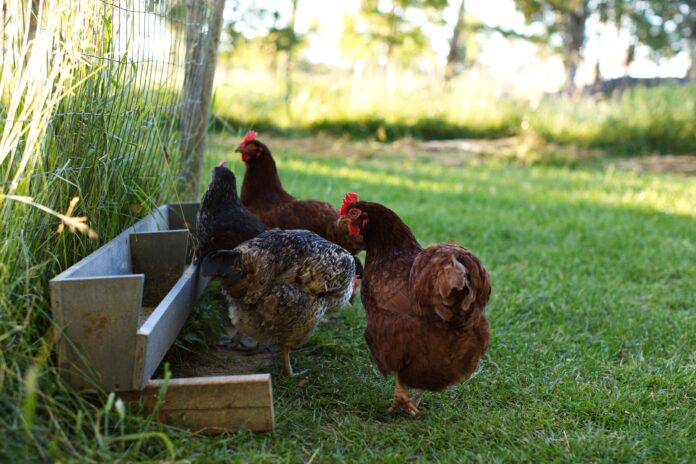MINDEMOYA—Birding is credited for being a coping mechanism for Bob Bell, who lives with Lyme disease.
“My book is really two stories in one,” stated Bob Bell, author of the book, ‘Out of the Lyme Light and into the Sunlight: Birding as Therapy for the Chronically Ill.’ First is my frustrating journey through the medical system with my Lyme, and then second, I sing the virtues of birding as a wonderful coping mechanism for anyone dealing with a chronic health issue. I give tons of resources and tips on how to get into birding.”
Mr. Bell was the guest speaker at a Manitoulin Nature Club (MNC) meeting last Friday. He explained he had first been introduced to the club through his interest in the story of a western North American woodpecker, dubbed Meriwether, who had set up shop for a long time earlier this year on property owned by Bob and Phyllis Cacciotti of Kagawong. “Everyone I knew from southern Ontario was making the pilgrimage to see this rare bird. I don’t normally chase birds like this, but this bird seemed to be long staying.” He contacted the Cacciottis and drove up to Kagawong last February. “I had the opportunity to meet Bob and Phyllis who are great people and have become friends, and I did see Meriwether. It was at that time I found out that Phyllis is the president of MNC.”
Mr. Bell was born and raised in Northern Ontario and now lives in Ancaster.
“It was exactly 10 years ago in the fall of 2013 that I started to have problems with Lyme,” said Mr. Bell. He had spent 35 years as a mineral exploration geologist (27 years with INCO), working globally as both a field geologist and later as an executive.
“I had been on a trip to southern Africa and got bit by a bunch of bugs,” recalled Mr. Bell. “I came back home and then attended a wedding in Regina, Saskatchewan, where I wandered into some tall grass. A few days later I had massive chills and fever, and I remember at the time thinking I had previously contracted Dengue fever on a trip to Brazil, which also started with a fever and cold chills, and I remember the doctor who treated me for this telling me don’t get it a second time because it could prove to be fatal.”
Fortunately, the symptoms Mr. Bell had experienced only lasted three days.
However, by October of 2013, “some really weird things started to happen,” said Mr. Bell. “If I had slept on my side the night before I would wake up and that side would still have sleep sensations like numbness and pins and needles. I also had migratory-muscle pains and overwhelming fatigue.” He also suffered other symptoms like muscle twitches.
The problem was, “how could I convince anyone in the medical system that these symptoms were all related?” said Mr. Bell. “I even had cognitive issues and couldn’t even count out $1.75 in change to pay for a copy of the Globe and Mail newspaper.”
“I was over a year testing to find out what I have,” said Mr. Bell. He calls Lyme Disease “the great imitator because it includes the same symptoms of diseases such as Multiple Sclerosis and Parkinson’s disease.”
“The medical system didn’t believe I had Lyme disease,” said Mr. Bell.
After he got a blood test from a diagnostic laboratory situated in Silicone Valley in California, he took the results to his Toronto doctor, who said ‘of course they found you positive for Lyme, they want your business.’ “In fact, the lab had been set up by a person who had gone through a similar frustrating experience of not getting a Lyme diagnosis nor treatment, so had devoted his riches to inventing better diagnostic methods, with no ulterior motives or financial incentives to find one positive. This is an example of what I had to deal with.”
He stated that his daughter Candace told him at one point, ‘You would have been better off going to a veterinarian,’ given that dogs get inoculated with a Lyme vaccine.
After getting the positive Lyme diagnosis, Mr. Bell went under the care of a US doctor, who he estimated improved his health by 60 percent, but not enough to continue working, so he had to retire in late 2015.
Upon retirement, he moved to Ancaster and put bird feeders up on his property. “I did a lot of research on birds and took courses on various species. And the more I got involved, sitting at my desk studying about birds of the Hamilton area, and watching the birds in my yard, I found that I had less aches and pains, because it got my mind off my body.”
“The more I got interested in birding, the less pain I was experiencing,” said Mr. Bell. “It became basically a coping mechanism, it was cathartic, and so much so that my niece said one day that I should write a book about all of this.”
He did indeed write a book and after sending it to a few publishers the book was released in December 2022. “I love sharing my newfound passion of birding and getting people hooked on birding. More people caring about birds means more people thinking and talking about the environment, preserving green spaces, and climate change,” said Mr. Bell.
“My book is a story of hope,” stated Mr. Bell, who noted the cover of his book, which was designed and painted by his daughter Candace, shows a bluebird stomping on a giant tick. “It is a wonderful picture and ties together my passion of birding with my Lyme disease.”
Mr. Bell noted, “Lyme disease is highly curable, if one begins treatment with antibiotics immediately. I was 13 months from onset of symptoms to diagnosis, so I now live with chronic Lyme. The challenge is that less than 50 percent of people with Lyme are aware of having had an embedded tick, and of those, less than half get the diagnostic bullseye rash.”
One lingering mystery for Mr. Bell is whether his ongoing symptoms are due to an active Lyme bacteria infection or the result of an overactive immune system fighting something that is no longer there, triggering inflammation and pain.






